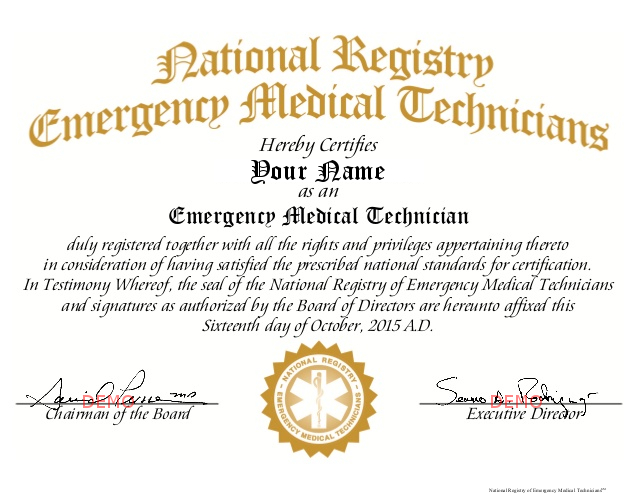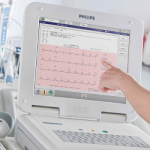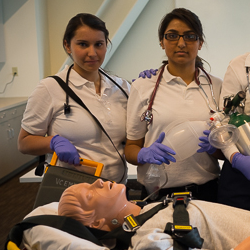What is an EMT?
Working as an EMT is a very serious job and shouldn’t be taken lightly.
An EMT, Emergency Medical Technician, is someone who provides immediate lifesaving care to people in dire situations.
Some of the types of things they may do include:
- Assisting with drug overdoses
- Intubation
- Perform CPR
All while chaos is going on around them.
This career takes a lot of mental focus, stamina, and a strong stomach.
Those who have a strong desire to help others are best suited for this field.
Duties
Along with providing interventions like intubation and CPR, an EMT has many duties that need to be done quickly, such as:
- Assist in administering medications
- Start IVs
- Provide airway management assistance
- Resuscitate patients
- Prepare patients to be transported
Though an EMT has most of the same duties as a Paramedic, they are not allowed to perform procedures on patients like applying pacemakers or administering drugs.
Salary
Most EMTs with minimum education will make around $36,930 a year in the United States.
Those who have just begun their career as an EMT will make less, closer to $28,320 a year in some parts of the country.
While knowledge gained and time served, it is possible for an EMT to make over $60,000 a year.
EMTs who work in Washington will make over $60,000, while an EMT working in Maryland may only make $49,000 a year.
Other factors that may contribute to your salary is the size of the hospital where you work, and the size of the population surrounding your job.
Hands-on experience and certification in CPR and other specialties will provide higher wages and a chance of promotions in this career.
Annually National Average Salary: $44,790
Average Annual Salary by State
| State | Avg. Annual Salary |
|---|---|
| Alabama | $37,680 |
| Alaska | $59,870 |
| Arizona | $39,700 |
| Arkansas | $35,650 |
| California | $51,830 |
| Connecticut | $50,740 |
| Delaware | $47,860 |
| District of Columbia | $51,400 |
| Florida | $43,380 |
| Georgia | $40,720 |
| Hawaii | $64,670 |
| Idaho | $39,700 |
| Illinois | $53,730 |
| Indiana | $42,310 |
| Iowa | $44,850 |
| Kansas | $35,780 |
| Kentucky | $37,960 |
| Louisiana | $34,940 |
| Maine | $45,420 |
| Maryland | $55,680 |
| Massachusetts | $49,620 |
| Michigan | $41,920 |
| Minnesota | $46,350 |
| Mississippi | $35,380 |
| Missouri | $40,800 |
| Montana | $36,250 |
| Nebraska | $45,460 |
| Nevada | $42,350 |
| New Hampshire | $45,040 |
| New Jersey | $51,630 |
| New Mexico | $40,210 |
| New York | $49,440 |
| North Carolina | $43,140 |
| North Dakota | $41,620 |
| Ohio | $40,450 |
| Oklahoma | $34,960 |
| Oregon | $48,780 |
| Pennsylvania | $41,310 |
| Rhode Island | $48,490 |
| South Carolina | $39,840 |
| South Dakota | $39,520 |
| Tennessee | $40,090 |
| Texas | $39,690 |
| Utah | $39,120 |
| Vermont | $41,430 |
| Virginia | $44,740 |
| Washington | $49,760 |
| West Virginia | $35,430 |
| Wisconsin | $44,670 |
| Wyoming | $43,140 |
| Puerto Rico | $29,420 |
| Virgin Islands | $42,840 |
Annual Average Salary: Top 5 States
The top earning state in the field is Hawaii, where the average salary is $64,670.
These are the top 5 earning states in the field:
* Employment conditions in your area may vary.
How to Become an EMT
Step 1 Enter a Program
Working as an EMT, you will definitely benefit from some type of education program.
There are a couple of options for programs for EMT’s, for example, there are one-year programs through trade schools or medical facilities.
Other people choose to work toward an Associate’s degree, which takes about two years to finish, and often provides an externship to gain hands-on experience.
In order to enroll in a one-year program or an Associate’s degree program, you must have:
- A high school diploma or GED
- 5 GPA
- Be at least 18 years old
- Be CPR certified
Some of the types of things you can expect to learn in any EMT program are:
- Fundamentals of patient care
- How to control bleeding
- Cardiac emergency response
- How to assess patient condition
- How to manage airways
With an Associates degree program, there will likely be many other classes, including:
- Anatomy and Physiology
- Medical Terminology
- Bloodborne Pathogens
- Childbirth
Step 2 Become Licensed
After completing an EMT training program, whether a one-year program or an Associate’s degree, you must take the EMT certification exam given by the National Registry of Emergency Technicians.
This exam will show that you are capable of doing your job as an EMT and that you have the knowledge and ethics needed for this career.
The exam is given through the computer and is typically around 120 questions.
You can expect to pay around $80 to take this exam.
Some of the areas of interest for the EMT certification exam are:
- Airway, respiration, and ventilation
- Cardiology and resuscitation
- Trauma
- EMS Operations
- Medical; OBGYN
If you do not pass the exam the first time you take it, you will be allowed 6 tries in total.
Once you pass the exam, you will be able to work as a licensed EMT.
Step 3 Gain Experience
Being licensed is extremely important in this career, but hands-on experience is key as well.
When you start your journey to become an EMT, you should make sure that the program you enroll in has some type of externship or ability for you to gain experience while also getting school credit.
Externships can allow you to work in places like:
- Hospitals
- Clinics
- Emergency Centers
Once you become licensed, then you can take what you learned through your schooling and apply it to your job.
There are many opportunities for EMT’s around the hospital and beyond, including:
- Search and Rescue Medic
- Ski Patrol Medic
- EMS Instructor
- Flight Paramedic
- Firefighter
Having at least two years of experience as an EMT will provide you the opportunity to gain promotions in the field, as well as the possibility for certification or specialization.
Step 4 Become a Paramedic
On your journey to becoming an EMT, you may have realized that you won’t have as many responsibilities as a Paramedic.
That is because Paramedics need more education to do the tasks that they’re required to do.
Most Paramedic programs will last another 1-2 years, depending on the type of program you enter.
It’s possible to earn a Bachelor’s degree as a Paramedic through some universities.
While learning to become a Paramedic, you can expect to learn things like:
- How to administer medication
- Start IVs
- Stitching wounds
- Intubating patients
It’s possible to gain specialization in a specific field as an EMT or paramedic, including:
- Pediatrics
- Obstetrical emergencies
- Cardiac care
- Trauma
Once you become a Paramedic, you can then be promoted into a supervisor role.
Beyond that, your career opportunities are endless.
Popular Programs
Education
As an EMT, you have a couple of choices when it comes to the type of education you want to receive.
You can earn a one-year certificate, which can be done online or at local trade schools or community colleges.
or, you can work toward an Associate’s degree, which can lead to promotions and even a Bachelor’s degree.
A one year program can provide entry-level education as an EMT.
Some of the types of things you will learn through this type of program include:
- Medical Terminology
- Anatomy and Physiology
- Patient Care
- Hazardous Materials
- First Responder courses
Those who earn a one year certificate will want to make sure that their program is accredited with the National Registry of Emergency Technicians.
This association is the only one approved to license EMTs, and you will need to graduate from an accredited program in order to become licensed.
Programs are available throughout the country, some are online and some are in the classroom.
The important part is that you gain hands-on experience in real life.
This means you may have to take an internship or externship in order to become knowledgeable about the career.
You will also need to take labs and clinicals, and you may even want to shadow a fellow EMT to see what they do on a daily basis.
Learning and gaining experience are the most important parts of working as an EMT.
Due to the nature of the career, many EMTs choose to go through an Associate’s degree program.
Lasting around two years, an Associates degree program is your doorstep into higher levels in the medical field.
EMT Associates degree programs can be found at local colleges and universities, as well as online.
These programs will delve deeper into the world of EMTs, providing students with courses such as:
- Basic Life Support
- Respiratory and Cardiac Arrest
- Pharmacology
- Management of ACS and Stroke
- Effective Communication
After earning an Associate’s degree, you can work toward becoming a Paramedic and gain a Bachelor’s degree.
This will take another two to four years, depending on the university.
Video About The Career
Licensing and Certification
There are many states that require EMTs to become licensed once they graduate from an accredited program.
This licensure comes from the National Registry of Emergency Technicians and has several requirements.
In order to gain licensure, prospective must take the EMTs must take the Emergency Medical Technician certification exam.
Also, a fee of $80 must be paid before taking the exam.
There are two parts to the exam, which must both be taken and passed before becoming licensed:
- Cognitive exam
- Psychomotor exam
The cognitive exam is a computer adaptive test, which means that when you answer more questions correctly, you will need to answer fewer questions.
Most exams average between 70 to 120 questions and are multiple-choice.
Some of the types of things to expect in the Emergency Medical Technician certification exam are:
- Airway
- Cardiology and Resuscitation
- Trauma
- OBGYN
- Pediatric Patients
- EMS Operations
There is a minimum passing score that is allowed for this exam, and it changes all of the time, so check your local board to find out more information.
The psychomotor exam is an exam to show that you are capable of physically and mentally handle the job.
This exam is performed by the training program that you graduated from, and should consist of the following demonstrations:
- Management of a trauma patient
- Cardiac arrest management
- Bone immobilization
- Bleeding control
- Shock management
- CPR
All prospective EMTs will have to demonstrate that they can do all of the above, as well as more procedures not listed.
The instructor must sign off on the exam and submit it to the association.
Once both parts of the test are completed, then you will be a licensed EMT and can work in the state that you took the exam.
This licensure needs to be renewed every two years, and in order to gain renewal, EMTs must show:
- At least 20 hours of continued education
- Or that they have retaken the exam
Certification Example:

Average Training Program Duration: 1-2 Years
Some EMT programs can take about one year to finish and can lead to a certificate.
These programs can be done online or in classrooms at trade schools or community colleges across the United States.
There may be some physical and mental aspects to the program, due to the nature of the career.
Some programs also require that students participate in a minimum amount of externship hours.
This could be anywhere from 50-120, depending on the school.
It could take anywhere from 1 year to 2 years to finish an EMT program.
Job Outlook
There will likely be a growth of career opportunities for EMT’s of around 11 percent over the next couple of years.
Due to an increasing number of car accidents, as well as other health-related issues, EMTs are needed more now than ever before.
Also, the baby boomer generation is growing older, which means that the need will likely increase even more over the next decade.
If you are looking to start a career as an EMT, now would be a great time to begin.
Employment Growth Projection: 6%
2023
2033
That's a higher than average projected growth of 10,300
Should You Become an EMT?
Overall Satisfaction: Medium

This career can be extremely stressful, so it takes someone with thick skin to be successful.
Working with people in their scariest or most painful moments can be triggering.
The hours can be rough as well, often working over-nights and overtime.
That doesn’t mean this job is all bad, EMT’s find this career to be a good choice because they are helping people and their community.
Average Salary: Medium

Most EMTs in the United States will make about $36,930 a year.
After several years of experience and education, you can expect to make over $60,000 in some areas as an EMT.
However, when just starting out in this field, you’ll make close to $28,320 a year.
Those working in large hospitals or in higher populated areas will likely find better wages and career opportunities.
Certifications and specializations will also play a role in how much money you can make a year as an EMT.
Job Growth Outlook: Medium

EMTs have an important job, and will likely be needed for many years to come.
This being said, the career will grow around 11 percent over the next decade.
Across the medical field, this career will grow at about the same rate as other careers.
The rise in this career is due to the baby boomer generation growing older and needing more medical care, as well as advancements in technology which have made it easier to treat patients in emergencies.
People who have experience in the medical field and enjoy helping others will find the most job prospects in this area.
Education Duration: 1-2 Years

Depending on the type of program that you enter into, it can take anywhere from 1 to 2 years to become an EMT.
A type EMT program can take about one year to finish, and provides basic level education to start your career as an EMT.
These programs can be found online or locally at trade schools and community colleges.
Other types of programs that result in an Associate’s degree can take about two years to finish.
These programs will provide more hands-on experience, as can lead to more career opportunities.
Personal Skills Needed

It’s important to be calm, cool and collected as an EMT.
Often, the situations that you will be working in will be chaotic and scary.
Some of the personal skills that you should strive for in this career are:
- Ability to work as a team
- Communication skills
- Empathy
- Compassion
- Ability to navigate stressful or difficult situations with ease
- Critical thinking skills
- Mental toughness
- Physical stamina
- Situational awareness
- Problem-solving skills
- Attention to detail
Make sure that you learn enough about the medical field to guarantee a successful career as an EMT.
Frequently Asked Questions
How much does an EMT make?
More education means a higher salary for an EMT.
If you are an EMT and you have an Associate’s degree, it’s likely that you can make up to $36,930 a year in most states.
However, with more education and experience, it’s possible to make over $60,000 a year as an EMT in areas like Washington and New York.
Those who just started their career as EMTs should expect a salary closer to $28,320 a year.
This is due to experience levels and certifications, once you become more educated in the career, your wages will increase.
How long does it take to become an EMT?
There are a lot of things that you need to learn in order to work as an EMT.
That’s why it can take a year or more to start this career.
The average EMT training program takes about one year to finish and offers entry-level education.
For those who are looking for more, an Associate’s degree is available.
This type of program can take about two years to finish for full-time students.
On average, it takes anywhere from 1-2 years to become an EMT.
What does an EMT do?
An EMT works hard, helping victims of accidents, trauma, medical issues, and much more.
These brave people are the first ones on the scene after a 911 call and are there to make sure everyone is okay.
If they find someone who is sick or injured, they will work their hardest to help the person immediately.
Sometimes, they will take patients away in an ambulance to be helped at the hospital.
What is the demand for EMTs?
EMTs are important in the medical field, so there will always be a need for them.
With the baby boomer generation aging out of the working class, it is likely that more EMTs will be needed in the near future.
Along with technological advancements in medicine, the ability for EMTs to work successfully and immediately with patients has increased.
Those who are looking to start a career as an EMT would be smart to do it soon.
How much does it cost to become an EMT?
There are many types of programs that an EMT can enroll in, and they can cost different prices as well.
A one-year program can cost anywhere from $1,500 to $5,000, depending on the program and the type of school you work with.
An Associate’s degree takes about two years, so it will cost a bit more.
Most degree programs cost anywhere from $10,000 to $15,000, depending on the school as well.
Earning a Bachelor’s degree can cost an additional $20,000 or more.
EMT Resources
More Medical Careers
| Career | |
|---|---|
 | Certified Nursing Assistant Working as a Certified Nursing Assistant is an entry-level role that will give you hands-on experience when you are ready to take the next step in your medical career. |
 | Dental Assistant Dental assistants help dentists to provide patient care, keep records, and care for the dental equipment. |
 | Dental Hygienist Dental hygienists take care of cleaning teeth to promote hygiene and help avoid cavities and gum problems. |
 | Dialysis Technician Dialysis technicians maintain and monitor dialysis equipment, and also act as primary caregivers for patients undergoing dialysis treatment. |
 | Dog Groomer Dog groomers attend to grooming dogs, usually at dog salons or big pet-related chain stores. |
 | Healthcare Administrator Healthcare administrators – also known as healthcare executives or health services managers – are responsible for the planning, direction, and coordination of medical and health services. |
 | Home Health Aide Home health aides provide home care to individuals who require assistance in their day-to-day living. |
 | Licensed Practical Nurse (LPN) Licensed Practical Nurses provide basic nursing care to patients and work with Registered Nurses and Doctors. |
 | Medical Assistant Medical assistants support the work of physicians, nurses, and other health professionals. |
 | Medical Biller and Coder Medical billers and coders manage, organize, and code various health information data. |
 | Medical Technologist Medical laboratory technologists collect bodily samples and conduct tests to analyze those samples. |
 | Medical Transcriptionist Medical transcriptionists go over voice recordings to convert them into written texts. |
 | Nutritionist As a Nutritionist, you’ll be tasked with creating meal plans, counseling, and understanding dietary restrictions for all types of clients. |
 | Patient Access Representative The work involves helping people to orient themselves to the space and everything that is going on. |
 | Patient Care Technician Patient care techs work directly with patients helping them with daily activities and assist the medical staff by measuring and monitoring the patients' vital signs among other tasks. |
 | Pharmacy Technician Pharmacy technicians provide patients with medications through prescription or over the counter. |
 | Phlebotomist As a Phlebotomist, it will be your responsibility to take blood samples from patients and send them to the lab for further testing. |
 | Physical Therapist Assistant Physical therapist assistants provide physical therapy services to patients and aide to physical therapists. |
 | Professional Recovery Coach A professional recovery coach is a life coach who works with someone during their addiction recovery process. |
 | Radiation Therapist Allied health provisional who specializes in radiation oncology treatments. |
 | Registered Health Information Technician Registered Health Information Technician (RHIT) help store and verify accuracy of health records as well as analyze patient data. |
 | Registered Nurse (RN) Registered Nurses provide hands-on patient care in various settings, mainly hospitals, and clinics. |
 | Respiratory Therapist Respiratory therapists treat and care for patients who experience breathing difficulties. |
 | Sterile Processing Technician A sterile processing technician is a healthcare professional who is responsible for preparing, sterilizing, maintaining, packaging, and storing medical tools and equipment used in surgical and other medical procedures. |
 | Surgical Technologist Surgical technologists – also known as operating room techs – prepare operating rooms and assist doctors and nurses during surgical procedures. |
 | Vet Office Manager Veterinary office managers work to make sure that the daily operations run smoothly and efficiently at veterinary hospitals or veterinary clinics. |
 | Veterinary Assistant Veterinary Assistants work closely with Veterinarians to handle routine animal care. |
 | Veterinary Technician Veterinary Technicians assist veterinarians as well as diagnosing and treating animals, mostly in private clinics. |
 | EKG Technician EKG technicians test and monitor the cardiovascular system. |
 | MRI Technologist MRI Technologists use a machine to scan the body and create a detailed image of the inside for doctors to analyze. |
 | Optician Opticians are technicians and salespersons at the same time who spends most of their day talking to customers, reading prescriptions written by doctors, and dispensing glasses and lenses. |
 | Ultrasound Technician Ultrasound technicians aid physicians in monitoring and diagnosing patients through the use of ultrasonic imaging technology. |
 | X-Ray Technician X-Ray Technicians are medical imaging professionals who use technology to visualize the inside of our bodies. |













